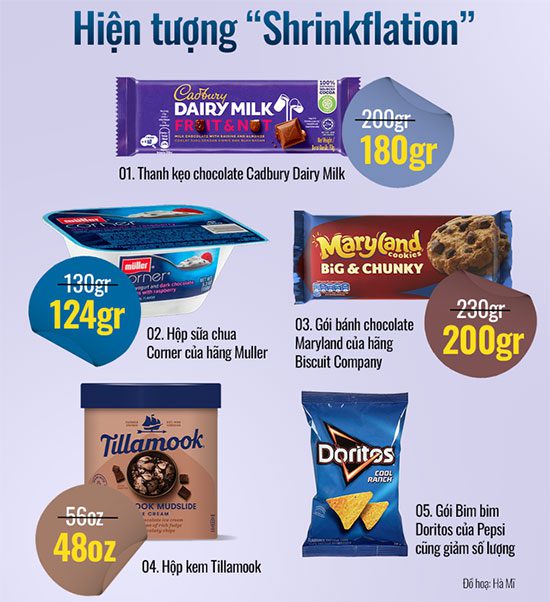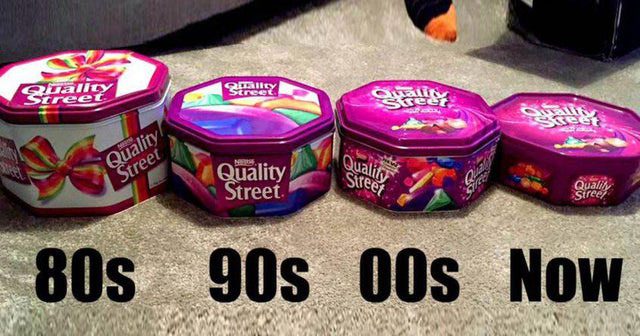In today’s inflationary environment, it is well-known that many products have increased in price. However, few people notice that the items they purchase have also decreased in quantity or even quality.
In fact, many products today, ranging from chocolate bars to snack packs, soup cans, sausages, and dishwashing liquids, have undergone slight changes in size, especially in the food sector.
For instance, Cadbury Dairy Milk chocolate bars have reduced from 200g to 180g, Muller’s Corner yogurt has dropped from 130g to 124g, and Maryland chocolate biscuits from Biscuit Company have shrunk from 230g to 200g.

Tillamook ice cream has decreased in weight from 56oz to 48oz, while Pepsi’s Doritos snack packs have also reduced in quantity, and Domino’s Pizza has cut down the number of chicken wings in their takeout combo meals.
This phenomenon of reducing product units is referred to by economists as “Shrinkflation”, where items are downsized in size or quantity, or sometimes even reformulated, resulting in reduced quality while the price remains the same or increases.
The main reason is that companies are forced to cut product units and sell less per finished product to maintain prices, thus avoiding a loss in sales during inflationary times and preserving brand image.
While many supermarket chains in the U.S., such as Costco, have kept the price of rotisserie chicken steady for the past decade by increasing prices on other items to compensate, many brands cannot do the same.
Widespread Impact
The term “Shrinkflation” first appeared in 1969 when journalist Arthur Buchwald wrote satirical commentary on inflation. The term began to gain widespread recognition in the 1970s as numerous manufacturers sought to protect their profit margins amid rising costs and slowing growth, leading them to devise new strategies.
Today, the issue of reducing product units is not new; however, because the reductions are often minimal, they do not attract consumer attention. Bloomberg reports that this situation is occurring globally, from Australia to India, and across the UK and the U.S.
In the UK, the “Shrinkflation” phenomenon emerged after the public voted to leave the European Union (EU), known as Brexit. Mondelez International reduced the weight of its Toblerone chocolate bar but had to revert to the original size after consumer backlash.

Manufacturers are cautious in reducing product units.
According to Bloomberg, to make it difficult for consumers to notice, manufacturers are very careful in reducing product units. They may keep the size the same but slightly reduce the weight, leading customers to unknowingly purchase less for the same amount of money.
In agreement, the online retailer Britsuperstore, using analytical data from “Money Saving Expert”, noted that British consumers are complaining significantly about chocolate, followed by cheese and milk, as the sizes of these products have changed from what they used to be.
Despairing Choices
Bloomberg reports that in the current inflationary climate, consumers may not have many options if they wish to continue purchasing items at old prices. They will have to accept that product quality will not be the same as before or pay more.
According to Bloomberg, this reduction in product units often occurs with major brands that aim to maintain their reputation, so customers might consider seeking out less well-known brands. At least smaller brands will raise product prices rather than incur additional costs to change unit sizes and maintain their image.
From the company’s perspective, numerous justifications have been presented for this action. Some argue that customers are still willing to buy less if the price remains unchanged, while others claim they are protecting consumer health with less sugary products or safeguarding the environment…
For Mondelez, the company stated that this is the first time in a decade it has had to reduce the size of the Dairy Milk chocolate bar to remain competitive and ensure sales against rivals as costs rise due to inflation.
Meanwhile, a survey from Shopmate revealed that 50% of retail stores in the UK believe that the best brands are reducing sizes rather than increasing product prices, as customers today are very price-sensitive, and this greatly impacts sales.


















































